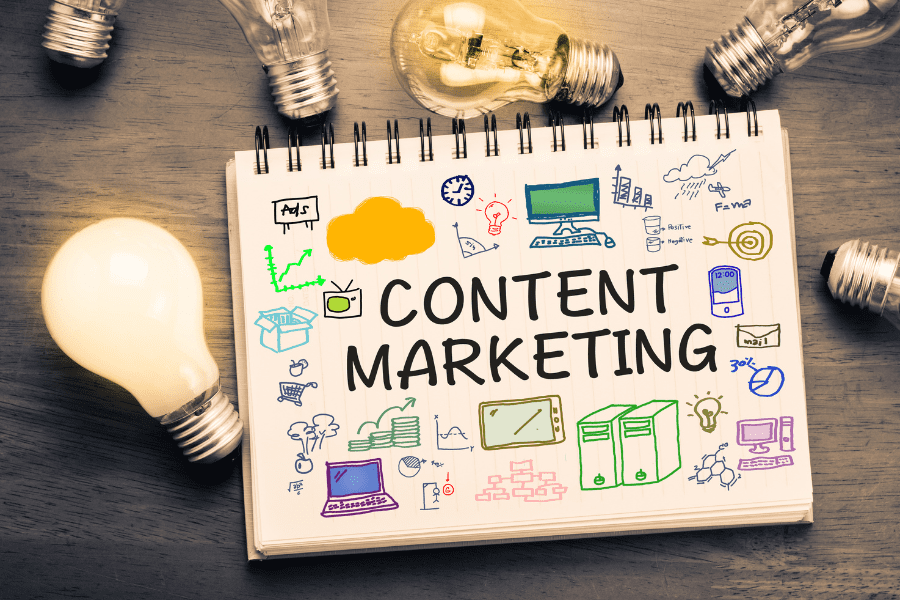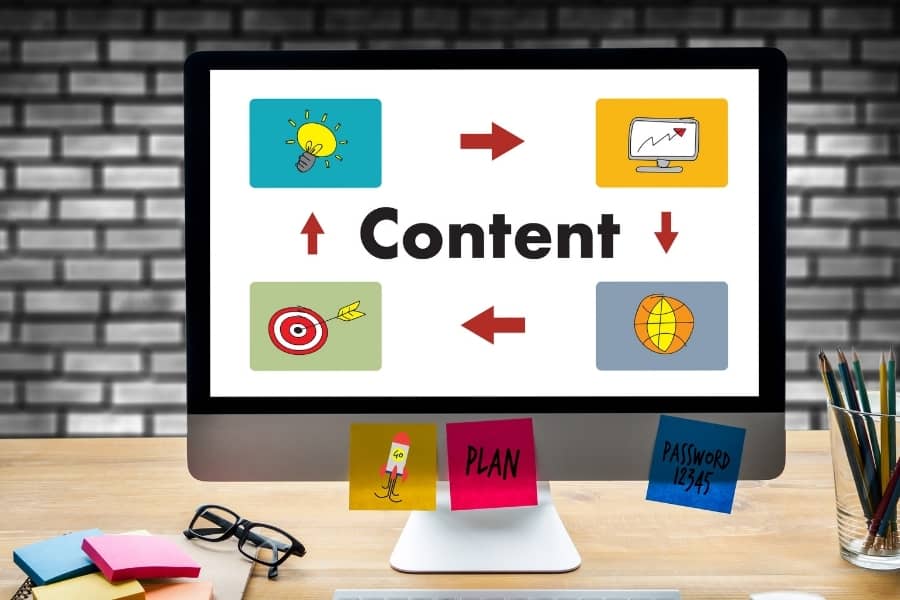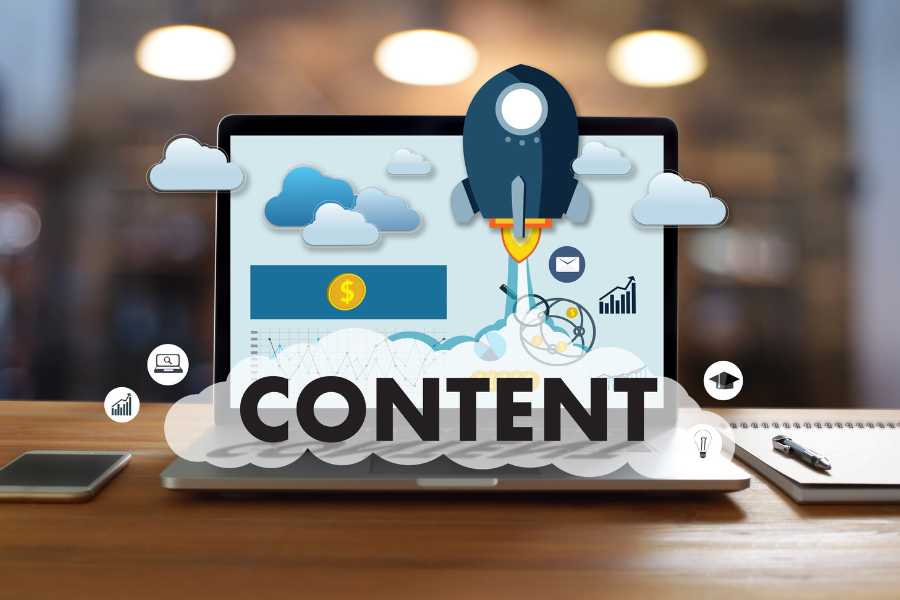Ever wondered, “what is content marketing, really?”
Imagine cooking your favorite dish, meticulously choosing the best ingredients, and presenting it in the most appetizing way possible.
Content marketing works similarly.
It’s about curating quality content, tailored for your audience, and served on a platter of strategic placement.
From blog posts to social media buzz, it’s a game-changer for businesses big and small.
Ready to taste the secret sauce to boosting online visibility and customer engagement?
Let’s dive right in!

What is Content Marketing?
Content marketing is a strategic marketing channel that drives user and customer acquisition and retention through the consistent development and distribution of digital content.
All types of businesses use content marketing, from individual consultants and solopreneurs, to large media and ecommerce companies.
Why is Content Marketing Important?
Many marketing teams new to the content marketing process will publish a few articles, track their performance for a few weeks, and then throw up their hands in frustration when Google Analytics shows that they didn’t make any sales.
“We tried content marketing and it didn’t work” they’ll say, and then move onto the next channel experiment to find their golden ticket to marketing nirvana.
But the truth is, they didn’t give content marketing a fair shake.
Content Marketing Acts as the Engine for All Other Marketing Efforts

The majority of content-driven sales won’t show up as “last touch” conversions. That’s because content marketing rarely gets the credit for the sales it has a big hand in driving.
Not sure what I mean?
Consider the following customer journey scenario:
You’re traveling to Europe for business, and when you arrive at your destination, you need to be on your A-game, as you’re meeting a potential customer that would be career-making if you were to land their business.
The problem?
Between the dehydration, jet lag, bloating, and headaches, you never feel good when you fly.
But because this is such an important business trip, and you know it’s extra important to stay healthy while you’re traveling, you try to find solutions on Google.
You type in “healthy travel tips” and find this article with 12 strategies to stay healthy and feel better before, during, and after your flight.
After reading the blog post, you continue planning your trip. The next day, you’re browsing Facebook or LinkedIn and you see an ad for a health supplement to support your body while traveling.
When you click on the ad, you’re brought to the same site you visited the day before.
When you go to leave the page, a form slides in offering you a 10% discount in exchange for your email. You enter your email address and then go back to browsing a social media platform.
The next day, you open your inbox and find an email with your coupon code for 10% off the drink mix. You use the coupon at checkout and feel prepared for the long flight ahead of you.
Now, when the company’s marketing team reviews their metrics, your purchase will likely be attributed to email marketing. That’s because you bought the product from the follow-up email they sent you.
However, without good content marketing, you never would have been retargeted on Facebook or LinkedIn with the advertisement that led you to become a subscriber to their email list.
In other words:
A content marketing campaign is often a customer’s first interaction with you.
What are the Benefits of Content Marketing?

Of the many marketing channels available to digital marketers, content marketing is one of the channels with the widest-reaching benefits, because it enables many other channels to be more effective.
A successful content marketing program will also benefit all stages of the content marketing funnel.
Here’s how…
1. Drives Sales Conversions
As with any inbound marketing channel, the main purpose of any content marketing effort is to drive sales and conversions.
Some content closer to the bottom of the content marketing funnel, such as sales pages and landing pages, will drive direct conversions, but the majority of content captures users at the awareness and interest stages of the funnel, so they assist in driving sales, as mentioned in the earlier scenario.
2. Increases Website Traffic
With a few exceptions, you can’t convert people who never land on your website.
Experienced marketers look to content marketing to drive traffic to their websites and grow their customer base.
The best part about content marketing is that the traffic a good content strategy can drive is targeted and qualified.
You create valuable content that is highly relevant to your products or business, and your new visitors are seeking that content, so they’re more likely to be warmer leads.
The warmer the lead, the more likely the lead will become a new customer.
3. Improves Brand Awareness
Say you were to launch a new yoga gear brand from scratch. You have no traffic, no customers, and no brand awareness. Nobody knows who you are.
But then, you begin publishing consistent content that’s high quality. And your ideal customers — beginner yogis and yoga enthusiasts — start to see your brand name when they’re searching for yoga content.
On YouTube, the 5-Minute Morning Yoga video content you developed is popping up when they’re searching for guided yoga videos.
On Google, the content you developed about the different poses, and the benefits and types of yoga begins to show up in their search results.
They begin to see your brandmark on the infographic you developed that’s been shared on social media platform.
As you create and publish more relevant content, your target audience begins seeing your brand everywhere — you build brand awareness.
That’s because effective content marketing is extremely powerful in building brand awareness online. So powerful, a whopping 81% of survey respondents in a recent CMI report touted content marketing’s effectiveness in boosting brand awareness.
In short, it works.
4. Acts as a Backlink Magnet
Whether valid or not, backlinks are still often viewed as the holy grail of digital marketing.
“If we had more backlinks, we’d be able to rank for this search term, have a better domain authority, and be more trustworthy.”
“If we had more backlinks, we’d be able to attract more partners, affiliates, and influencers.”
But “link building” should not be used as a verb. It’s not something you should go out and do.
After all, the sites that are willing to link to your article because you reached out to them and asked them to, or in exchange for a monetary reward or reciprocal action, are probably not the type of websites you want links from.
Those who write for or operate the websites that you want links from — the media sites, popular bloggers, and influencers — link to the best, most relevant content, because they don’t want to waste their audience’s attention on anything else.
When you publish the best content on the internet about your topic, you’re building a backlink magnet. Backlinks will come to you. You won’t have to seek them.
5. Builds Your Email List
Aside from content marketing, email marketing is the channel well known for having one of the highest return on investments available.
It makes sense too.
A list of people who wanted to hear from you enough to give you their email address are far more likely to convert than anybody else — besides maybe your mom.
Content marketing provides ample opportunity not only to drive qualified traffic from whom to capture emails, as mentioned above, but also to incentivize visitors to subscribe to your email list.
The Essential Types of Content Marketing

When many people think of content marketing, they think mainly of written content, such as blog posts. While this is the most widely-known content type, there are different mediums through which to deliver content, including audio, visual, written, and video.
Written Content
Written content is the most widely known form of content, and is what you’re consuming right now as you read this guide. This includes:
- Blogging (articles and posts)
- Ebooks
- Whitepapers
- Swipe files
- Case studies
Written content is the most popular form of content for good reason: it allows you to target relevant keywords in hopes of ranking on the first page in search results for that search term.
For example, our SEO (search engine optimization) friendly Smart Blogger website ranks #1 for the popular search term “smart goal examples”
This undoubtedly brings in plenty of traffic.
Yet, it’s not instantaneous.
It takes time to build great content and time for Google to turn your efforts into rewards.
Audio Content
Most of us consume audio content regularly, in the car on our way to work, on the treadmill, or in the kitchen cooking.
Examples of content in audio format include:
- Podcasts
- Audiobooks
- Radio shows
If you’re a regular listener of podcasts, you probably feel like you know the show host somewhat personally. That’s because it’s hard not to feel friendly with somebody when you hear their voice talking about something that matters to you every day!
Audio content allows you to connect with your audience more personally. Many marketers supplement their audio content with written content like a blog post or transcript to help rank for relevant keywords.
Video Content
When you think of search engines, you probably think of Google, Bing, and Yahoo, right?
But believe it or not, YouTube is one of the largest search engines in the world. Every time you watch something online, you’re consuming video content.
Video content exists on:
As our friends over at Ahrefs prove, video marketing can be highly effective in educating, converting, and building brand awareness:
So, why not give it a go? If not, perhaps the next content marketing strategy appeals to you…
Visual Content
Visual content, an immensely crucial aspect of content marketing, carries the power to transform mundane facts and data into an engaging, digestible, and memorable user experience. This type of content comes in a myriad of forms, including:
- Infographics
- Slide Decks
- GIFs
- Memes etc.
High-quality visual content is typically developed to supplement and enhance written or video content.
Yet, it can also stand on its own.
A well-made infographic or a compelling slide deck can provide valuable information without the need for additional context or explanation.
5 Top Content Marketing Strategies to Elevate Your Digital Campaigns
As the digital world continues to evolve, staying ahead requires implementing cutting-edge tactics. Here are 5 top content marketing strategies to elevate your digital campaigns to new heights…
1. Repurpose Old Content

Your old content isn’t obsolete — it’s a goldmine waiting to be tapped!
Repurposing involves taking existing content and recreating it in a new format, giving it a fresh spin.
Here’s how you can do it: Look for evergreen content in your archive — the ones that are still relevant today.
Now, think about how you can present this information in a different way.
A how-to blog post could become a step-by-step video tutorial, and an interview could be turned into a series of inspirational quotes for social media.
Let’s take an example.
Say you have a podcast episode where you discuss the content marketing definition and strategies that writers can use to develop effective blog posts.
You could transcribe the podcast and turn it into a comprehensive blog post.
Then, pick out key tips from the blog post and create social media posts.
One piece of content with multiple uses!
Why go through this effort?
It saves you time on content creation, reaches more audience segments, and breathes new life into your top-performing content.
2. Use User-Generated Content
User-generated content (UGC) is like a gold stamp of approval from your customers.
It’s authentic, trustworthy, and completely free.
Sounds exciting, right?
UGC could be anything from reviews and testimonials to photos, videos, or blog posts. The trick is to encourage and facilitate it.
For instance, you could run a photo contest on Instagram where users post pictures of them using your product with a special hashtag.
Or, if you offer a service, request testimonials from satisfied clients and share them on your website and social media platforms.
The benefit?
User-generated content increases engagement and boosts credibility. Plus, it’s a fantastic way to showcase your customers’ love for your brand.
3. Learn from the Meme Culture
Memes are the language of the internet, and they’re an excellent tool to inject a dose of fun into your content marketing.
A well-placed meme can make your audience chuckle, making your content memorable and shareable.
Suppose you’re writing a blog post about common content marketing mistakes. You could include a meme showing a popular movie character making a funny mistake with a caption that relates to your point.
But remember, humor is subjective, so make sure it aligns with your brand voice and audience preference.
Another key to using memes effectively is staying current.
Keep up with trending memes and use them creatively to make your content more engaging.
4. Redefine Storytelling & Harness the Power of Audio

The power of storytelling isn’t just confined to text.
Audio content, in the form of podcasts and audiobooks, offers a unique opportunity to engage with your audience in a whole new way.
Imagine the convenience for your audience, being able to consume your content while driving, working out, or just relaxing.
Here’s a practical tip to kickstart your audio content journey: Pick one of your well-performing blog posts. Now, transform it into a podcast episode.
All you need is a decent microphone, a quiet room, and some recording software (there are plenty of free options available online).
To add a sprinkle of authenticity, consider inviting experts to discuss the topic.
Let’s say you have a blog post about the latest content marketing trends.
Convert it into a podcast episode where you discuss each trend, why it matters, and how businesses can implement it.
5. Engage with Your Audience
The era of one-way communication is over.
Successful content marketing involves interacting with your audience, understanding their needs, and building relationships.
This can be as simple as responding to comments on your blog and social media posts, or as elaborate as hosting a live Q&A session on your platform.
For instance, let’s say you’ve written a blog post about SEO strategies.
As the comments start coming in, don’t just leave them unanswered. Engage with your readers, answer their queries, and thank them for their input.
If someone shares an interesting insight, appreciate it publicly. This interaction makes your audience feel valued and heard.
Or consider hosting a live Q&A session on Instagram or Facebook where you answer your audience’s queries about content marketing.
Engaging with your audience fosters a sense of community, drives engagement, and builds loyalty toward your growing brand and business.
Plus, it offers invaluable insights into your audience’s needs and preferences.
What is Content Marketing to You?
It feels overwhelming, doesn’t it?
All this talk of content marketing and its other fancy jargon.
You might be wondering, “Can I really nail this?”
And to that, we say, “Absolutely, you can!”
With every bit of information in this guide, you’re one step closer to mastering effective content marketing and skyrocketing your sales.
The journey might be tough, but remember, each step you take is a step toward transforming your brand into a force to be reckoned with.
You’ve got this!
The post What is Content Marketing? A Basic Guide for 2023 (& Beyond) appeared first on Smart Blogger.

No comments:
Post a Comment